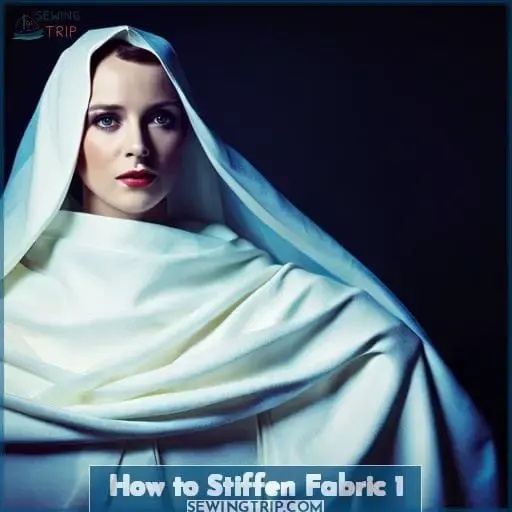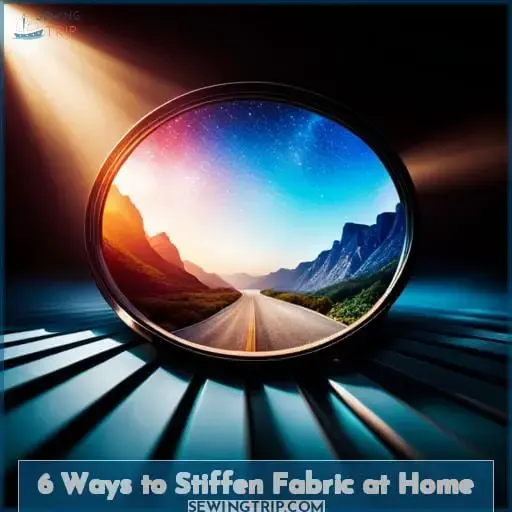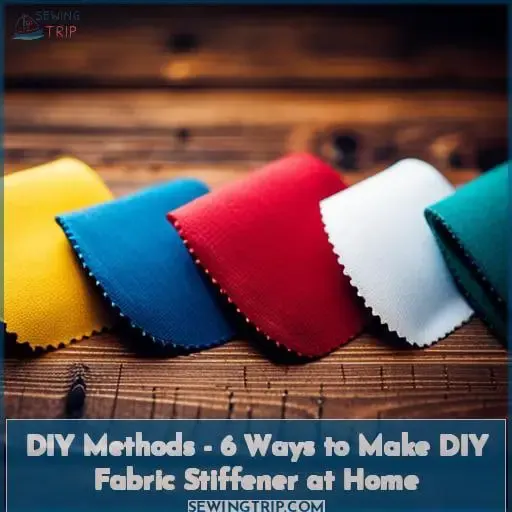This site is supported by our readers. We may earn a commission, at no cost to you, if you purchase through links.
 Are you looking to stiffen fabric? You can achieve a three-dimensional look with the right fabric stiffener! Whether you’re crafting, sewing, or making art sculptures, there are many DIY and commercial solutions available for how to stiffen fabric.
Are you looking to stiffen fabric? You can achieve a three-dimensional look with the right fabric stiffener! Whether you’re crafting, sewing, or making art sculptures, there are many DIY and commercial solutions available for how to stiffen fabric.
In this article, we’ll cover everything from what a fabric stiffener is and craft ideas to 6 ways of making your own homemade version at home. We’ll also discuss more embellishing ideas, such as why you need it in the first place and using interfacing (sew-in or iron-on).
Finally, we’ll explore some of the commercial options like Mod Podge Stiffy that will help give your fabrics an extra firm hold.
Table Of Contents
Key Takeaways
- Fabric stiffeners like glue recipes, starch, gelatin, and commercial products can be used to stiffen fabric.
- Different fabrics require different stiffening agents, some permanent and others wash out.
- Interfacing and boning are commonly used in sewing projects for fabric stiffening.
- Experimentation and practice are important for finding the right mix of ingredients and techniques for each project.
How to Stiffen Fabric
Discover the art of fabric stiffening and how it can elevate your craft or costuming projects to the next level. Fabric stiffener is a special product used to make fabrics hold their shape better, from lacework doilies and burlap flowers to hats made from felt or ribbon wreaths.
Whether you’re sewing skirts with interfacing or creating sculptures with starch, learning how to use these fabric softeners will provide you with the tools needed for professional results every time.
What is Fabric Stiffener
You can bring a unique structure and texture to any project by applying fabric stiffener – from intricate lacework to sturdy burlap sculptures! Different fabrics require different stiffening agents; some are permanent, others wash out.
Starch recipes such as corn starch mixed with water or rice water boiled down make great DIY options. Mod Podge, wood glue, and commercial products also work well for starching projects! To ensure the best results when stiffening fabric, experimentation is key – but once you find the right mix of ingredients for your crafty endeavor, you’ll be able to create beautiful pieces that hold their shape even after washing.
Craft Fabric Stiffening Ideas
With a few simple ingredients and the right technique, you can transform your fabric into an artistic masterpiece that holds its shape! Different fabrics require different stiffening agents. Permanent agents such as Mod Podge, wood glue, or Aleene’s Stiffen Quick are ideal for craft projects, while washable options like starch or sugar syrup boiled down make great DIY recipes.
Experimentation is key to finding the perfect mix of ingredients for each project.
Depending on your needs, use sprays with glue, gelatine, and even commercial products – just remember to reapply after washing if necessary! Unleash your creativity with fabric stiffener and create beautiful pieces like lacework doilies molded into unusual flowers or sturdy burlap sculptures sealed in place with a permanent finish.
How to Stiffen Fabric for Sewing
When it comes to sewing projects, interfacing or boning can be used to create structure and hold shape in fabric. Fabric types will determine which stiffening agents are most suitable: spray bottles of glue, starch, gelatin, or commercial products offer different levels of stiffness.
Non-fusible interfacing is also an option for heavier materials like denim or wool.
To ensure success with your project, try experimenting with various starching techniques and boning methods depending on the desired effect.
For a professional finish, choose the right fabrics for your project needs, then use appropriate stiffening agents from starches to sprays.
How to Stiffen Fabric for Craft and Costuming
Discover the art of manipulating fabric to create beautiful crafts and costumes, with a variety of stiffening agents for different fabrics and effects.
From spray bottles filled with glue or starch, to fusible interfacing for heavier materials like wool or denim – all offer unique stiffening solutions.
Sewing projects require experimentation to achieve desired results while commercial products are available if you’re in a rush!
DIY methods involve boiling rice water or mixing Elmer’s glue with water; these can be used on any fabric type from burlap flowers and ribbons to felt hats.
Reap the rewards by mastering the art of stiffening your projects – permanent agents will last wash after wash while others may need reapplying depending on their use.
Get creative with this powerful technique today!
6 Ways to Stiffen Fabric at Home
Whether you’re looking to give your craft projects a professional finish or trying to create the perfect costume for a special occasion, fabric stiffening is an essential skill. It can be done in various ways, from using interfacing and boning to creating your own glue recipe or starch mix.
You can even use gelatine if you want something that will hold its shape after washing.
How to Stiffen Fabric With Interfacing
You can take your sewing projects to the next level by adding interfacing – a fabric stiffener – to your fabrics for better shape retention.
Choose from hand-sewn or iron-on versions depending on what type of fabric you’re using and for which craft project. For example, lace doilies need starch recipes, while burlap flowers require two tablespoons of wood glue or other stiffening agents with a shiny side fused onto them with an iron.
There’s no limit when it comes to creating something unique out of stiffened fabric – just have fun and enjoy being creative!
How to Stiffen Fabric With Boning
Try adding boning to your fabric for a professional finish that will hold its shape – it’s an easy way to upgrade your projects! You can use materials such as polyester plastic or metal wires, depending on the craft of your choice.
To make sure you get the desired stiffening results, experiment with different types of fabric and techniques. For permanent stiffening, mix a cup of room temperature water with either commercial fabric stiffeners or boiling water and dip the material in it until completely saturated.
With this method, you’ll be able to create beautiful pieces while also preserving their original form for years!
How to Stiffen Fabric With Glue Recipe
Transform your fabric into a work of art with this easy glue recipe – an effortless way to create beautiful, stiff shapes that will last!
To get the perfect results for any project size or type of fabric, experiment with different types and ratios of PVA glue and wallpaper paste.
Dip fabrics in diluted mixture for permanent stiffness or spray onto surfaces like butterfly wings.
Dipping techniques vary based on desired outcome. Use in the sewing scene to add structure to skirts, hats, collars & cuffs – all while preserving their original form!
With this DIY fabric stiffener recipe method, you can craft unique pieces that stand out from the crowd.
How to Stiffen Fabric With Starch
Unleash your creativity by stiffening fabric with starch for a unique and professional finish! You can use starch types, such as corn or flour, in combination with water to achieve the desired stiffness of fabrics.
There are different methods you can try, including dipping or spraying the starch onto surfaces. When applying, remember that tips may vary depending on the fabric type, and the results will differ if you use different materials.
Craft sprays and commercial stiffener products like Modge Podge Stiffy are also popular options for achieving the desired stiffness levels.
How to Stiffen Fabric With Gelatine
Bring your ideas to life by using gelatin to give fabric a unique, professional look. There are various types of gelatins available for use, such as Knox and Diplomat, each with different properties. Drying techniques vary depending on the material used. Molding effects can also be achieved through application methods like dipping or spraying.
Washing results will depend on the particular glue type stiffener you choose, but crafting spray methods have an advantage over commercial products when it comes to long-lasting stiffness levels and controlling costs.
Interfacing is often used in combination with particular glues for creating desired shapes and designs.
More Embellishing Ideas
Stiffening fabric is an important skill to have if you want your craft projects and costumes to look professionally finished. Interfacing, either sew-in or iron-on, is a great way of stiffening fabric without adding too much bulk.
Sew-in interfacing can be used for heavier fabrics that won’t take the heat from the iron. Boning also comes in handy when you need a more structured shape; it’s perfect for corsets and bodices where extra support is necessary.
Why Do You Need to Stiffen Fabric
Stiffening your fabric can take your creations to the next level, so it’s important to understand why you need this skill. Fabric stiffener is a great permanent solution for the latest crafting projects, such as hats, wreaths, and flowers, which require a stiffer finish than usual.
Different types of fabrics have different applications when it comes to the fabric-stiffening process. You can use glue recipes with cups of room temperature water or starch mixes. Alternatively, you can opt for more permanent solutions like interfacing or boning that won’t wash out over time.
With experimentation, you’ll soon be able to find methods that work best for each project and create beautiful pieces with ease!
Using Interfacing (sew in or Iron On)
You can use interfacing to permanently stiffen fabric, whether it’s sew-in or iron-on, for a long-lasting finish. Common methods include glue recipes with cups of room temperature water and starch solutions like cornstarch mixed with boiling water.
Gelatin mixtures or sugar syrup also work well when sprayed on fabrics using spray bottles filled with hairspray or dipped into fabrics. Sewing patterns often call for boning, which is available in various sizes from most fabric stores.
For those looking to experiment, there are many techniques and commercially available fabric stiffeners that make the task easier! You’ll soon find what works best for your project, from intricate lacework doilies to burlap flowers.
Non-fusible Interfacing (Sew-in)
To achieve a professional finish, you can use sew-in non-fusible interfacing to permanently stiffen your fabric. Boning basics should be taken into consideration when selecting the type of fabric you’re using, as some require more or less stiffening than others.
When washing items with interfacing applied, remember to check the manufacturer’s instructions for best results. Interfacing is available in pre-packed pieces or by the side of the web and has various uses.
From small pieces used on collars and cuffs to large sections used on skirts and dresses.
With practice comes confidence, so don’t forget that experimenting will help find which method works best for each project!
Stiffening With Boning
You’ll be amazed at how quickly boning can transform your fabric into something extraordinary! Boning Basics should always be taken into consideration when selecting the type of material you’re using, as some require more or less stiffening than others.
Hand-applied liquid stiffeners are great for large projects such as a huge fabric bow. Experiment with different types of boning to get the best result – from traditional metal bones in various shapes (such as spiral and flat) to alternative materials like cardboard, craft foam, and plastic canvas.
With practice comes confidence, so don’t forget that experimenting with different boning techniques will help find which method works best for each project! From creating stiffened bowls and figures to making wings or collars – use this knowhow on any art project requiring stiffness away from fusible interfacing options.
How to Stiffen Fabric for Crafts or Clothes
For a professional finish, try using fabric stiffeners to give clothes or crafts an extra bit of shape and structure! Consider the type of fabric you are working with, as different types will require different interfacing.
Permanent stiffening agents can be used for a long-term solution, while washable ones offer more flexibility. DIY recipes like glue/water mixtures, cornstarch dips, and sugar syrup baths can also be used depending on your craft of choice.
DIY Methods – 6 Ways to Make DIY Fabric Stiffener at Home
Are you looking for an inexpensive way to stiffen fabric? DIY methods like cornstarch, Elmer’s glue, flour starch, rice starch, and gelatin are all great options that will help you achieve different results depending on the effect you’re after.
All of these ingredients can be easily found in your pantry or local store, and they require no special tools or equipment to apply.
Corn Starch
Mixing corn starch with water is a great way to create a light fabric stiffener – just spray or dip onto the fabric and let it dry!
Want to know what type of effect you’ll get? Depending on the fabric used, some will take longer than others.
Also, two tablespoons of corn starch per cup of water have been found to be effective for most types.
Stiffening your fabrics creates unique shapes and textures, which adds an interesting touch to any craft project or costume item!
Elmer’s Glue
Create a unique texture and shape on your fabric using Elmer’s glue mixed with water! It’s an excellent medium for stiffening fabrics, perfect for crafting applications.
Before applying the mixture to any fabric, make sure you prepare it properly as different types of material will react differently.
To get started, all you need are two basic ingredients: Elmer’s Glue and some cool water. Follow any step-by-step tutorial online or experiment yourself to find out how various types of fabrics respond best when being stiffened with this simple concoction.
The possibilities are endless, so don’t hesitate to give this method a go today!
Flour Starch
Try using flour starch for an extra durable and long-lasting stiffened fabric that will keep its shape through the toughest of tasks.
With a simple mix of flour paste and water, you can craft beautiful bows or small utility bags with ease.
For more intricate items such as evening wear or Renaissance period clothing, dip your fabrics in a sugar syrup boiled from sugar cane before applying the glue mix to create a unique texture.
If crochet items are what you’re after, try boiling some rice then use its resulting water to dip into them for best results!
Whatever project you plan on taking up next – be sure to give fabric stiffening with these DIY methods a go today!
Rice Starch
Boiling rice and using its water to dip your fabric in is an easy way to craft a durable, stiffened material that will hold up against the toughest of tasks. Rice starch has properties that make it great for customizing stiffness depending on what kind of fabric you’re working with – from delicate lace doilies to burlap flowers.
The dip technique works best when combined with other materials such as glue or gelatine for extra strength and structure.
So if you want beautiful results without having to stand the heat – stay away from the kitchen and try some DIY methods today!
Gelatin
Dip your fabric in a mixture of gelatin and water to achieve a strong, durable finish that will last through any task! For craft projects such as lacework or doilies, it adds structure and stiffness.
Stretchy soft woven materials can benefit from the addition of synthetic strips of plastic for extra strength during the decoupage phase.
The final product holds its shape better than normal fabrics, giving artisans greater control over their creations.
Commercial Stiffeners
If you’re looking for a professional finish to your crafts, costumes, and dressmaking projects, commercial fabric stiffeners are an excellent choice. Two of the most popular options are Mod Podge Stiffy and Aleene’s Fabric Stiffener & Draping Liquid.
Plaid also offers their own version called Stiffy, while Beacon has one called Stiffen Stuff – all of these products can be used to create different types of effects with fabrics.
Mod Podge Stiffy
Mod Podge Stiffy is a great way to give fabric projects an instant boost. Just a few quick brush strokes and you’ll have fabrics that stay in place, craft materials with more structure, or solutions for any number of creative ideas.
Learn the basics of stiffening fabrics with Mod Podge Tips from experienced crafters who know best how to select the right material and apply it correctly.
Unlock your creativity today by unleashing the power of Mod Podge Stiffy!
Aleene’s Fabric Stiffener and Draping Liquid
Try Aleene’s Fabric Stiffener and Draping Liquid to transform your fabrics, crafts, and creations into works of art! With its unique combination of quick-drying liquid formulas, you can create stunningly shaped costumes or garments with just a few brush strokes.
It is suitable for all fabric types, from lace doilies to burlap flowers. You can also use it on stretchy materials like T-shirting or Lycra that don’t require starching.
Finally, it’s completely safe in washing machines, so no matter what project you choose, this may be the best solution available today!
Plaid Stiffy
For a professional finish, Plaid Stiffy is the perfect fabric stiffening solution to give your projects shape and definition. It can be used for any craft of your choice, from doilies to burlap flowers or even little girl’s costumes.
The unique combination of quick-drying liquid formulas makes it adjustable depending on the desired level of stiffness and will stay in place after washing – ideal for backdrops or wedding guest chairs! With this product, you get results that last without sacrificing preservation; some wash away while others remain permanent.
Get creative with Plaid Stiffy today and experience quality fabric preparation techniques like never before!
Beacon Stiffen Stuff
Discover the amazing results of Beacon Stiffen Stuff and revolutionize your fabric projects! This commercial product can be sprayed onto any fabric for a permanent stiffening effect. It’s perfect for doilies, burlap flowers, or costumes and won’t wash out – unlike some other DIY recipes.
With its unique combination of quick-drying liquid formulas, you’re sure to get the desired level of stiffness with ease.
Frequently Asked Questions (FAQs)
How long does fabric stiffening last?
The longevity of fabric stiffening depends on the type of product used, but most last through multiple washes. Stiffened materials remain even after washing and can often be reapplied to maintain shape and structure.
What fabrics are best suited for stiffening?
Stiffening fabrics can create unique looks and structures. Natural fabrics such as cotton, linen, burlap, wool, and silk are best suited for stiffening because of their absorbency.
What is the difference between interfacing and boning?
Interfacing is a woven or non-woven material used to add structure and stability, while boning adds shape and support. Both are often used in sewing projects; however, interfacing provides more flexibility than boning’s rigidity.
Are there any safety concerns when using fabric stiffener?
Yes, fabric stiffener can be toxic if inhaled or ingested and may cause skin irritation. Wear gloves when handling it and always work in a well-ventilated area. Read labels carefully to ensure the safe use of products.
Does the fabric stiffening process change the texture of the fabric?
The texture of the fabric may change depending on the stiffening process used. From glue to starch, gelatin or commercial products, each will affect it differently; some making fabric hard and crisp while others provide softer stiffness.
Conclusion
To conclude, fabric stiffening is a great tool to have in your craft toolbox. When used correctly, it can add a professional finish to any project. Whether you’re looking to make a costume, create a unique flower arrangement, or make a hat, there are many ways to stiffen fabric.
Whether you use a commercial product, make your own DIY stiffening agent, or use interfacing or boning – there’s an option for everyone. As the saying goes, Practice makes perfect! So keep experimenting and you’ll be sure to get the results you want.











